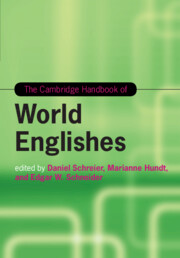Book contents
- The Cambridge Handbook of World Englishes
- Cambridge Handbooks in Language and Linguistics
- The Cambridge Handbook of World Englishes
- Copyright page
- Dedication
- Contents
- Figures
- Maps
- Tables
- Notes on Contributors
- 1 World Englishes: An Introduction
- Part I The Making of Englishes
- 2 The Colonial and Postcolonial Expansion of English
- 3 Theoretical Models of English as a World Language
- 4 The Contribution of Language Contact to the Emergence of World Englishes
- 5 Population Structure and the Emergence of World Englishes
- 6 World Englishes, Migration, and Diaspora
- Part II World Englishes Old and New
- Part III Linguistics and World Englishes
- Part IV Current Challenges
- Index
- References
4 - The Contribution of Language Contact to the Emergence of World Englishes
from Part I - The Making of Englishes
Published online by Cambridge University Press: 16 December 2019
- The Cambridge Handbook of World Englishes
- Cambridge Handbooks in Language and Linguistics
- The Cambridge Handbook of World Englishes
- Copyright page
- Dedication
- Contents
- Figures
- Maps
- Tables
- Notes on Contributors
- 1 World Englishes: An Introduction
- Part I The Making of Englishes
- 2 The Colonial and Postcolonial Expansion of English
- 3 Theoretical Models of English as a World Language
- 4 The Contribution of Language Contact to the Emergence of World Englishes
- 5 Population Structure and the Emergence of World Englishes
- 6 World Englishes, Migration, and Diaspora
- Part II World Englishes Old and New
- Part III Linguistics and World Englishes
- Part IV Current Challenges
- Index
- References
Summary
This chapter outlines the evolution of Englishes outside of the British Isles, with particular attention to exploitation colonies. It looks at contact between the English-speaking and indigenous language communities during Britain’s trade and colonization ventures from the seventeenth through nineteenth centuries but also highlights circumstances predating British colonization often overlooked in the field, comprising a larger group of players, in a chain of contact, such as that among various Asian communities, and with the Portuguese. Features such as tone, particles, and mixed codes are discussed; although traditionally regarded as the outcome of imperfect learning, such restructuring illustrates how, with diverse ecologies and typologies, there are no constraints on the typology of the emergent World Englishes (WEs) varieties. Also underscored is the fact that the dynamics and outcomes of contact in WEs are not distinct from those observed in scenarios in which creole languages evolve. The chapter concludes by evaluating the current and future evolution of English from contemporary contact ecologies, including computer-mediated communication, the language teaching industry, and trade.
Keywords
- Type
- Chapter
- Information
- The Cambridge Handbook of World Englishes , pp. 72 - 98Publisher: Cambridge University PressPrint publication year: 2020
References
- 2
- Cited by



